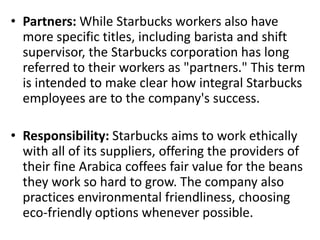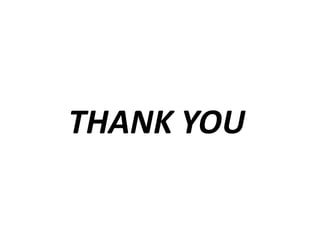Starbucks ppt
- 1. Starbucks Submitted by- Angelina Naorem 12LLB008 Submitted by: Angelina Naorem 12LLB008
- 2. Introduction • Starbucks Corporation - an American global coffee company based in Seattle, Washington. • Largest coffee-house company in the world with 20,891 stores in 62 countries. • President and CEO - Howard Schultz. • Places high value on ethical behaviour and company-wide diversity. • Offers espresso menu items, refreshments and pastries, merchandise, brewing accessories, gifts and books.
- 3. Company History • 1971- Starbucks founded by Jerry Baldwin, Zev Siegal and Gordon Bowker as a single store in Seattle’s Pike Place Market. • 1982- Schultz joins the Starbucks team. • 1983- While travelling in Italy, Schultz experiences Italian Coffee bars and inspires him. • 1985- Schultz leaves Starbucks to open II Giornale, a company serving espresso drinks using Starbucks coffee beans.
- 4. Company History • 1987- Schultz purchases Starbucks from the founders and begins to expand throughout the US. • 1992- Starbucks Company goes public. • 1993- Opens first roasting plant in Washington. • 2011- Celebrates 40th anniversary.
- 5. Mission Statement • “To inspire and nurture the human spirit – one person, one cup and one neighbourhood at a time.” • This is done through their commitment to the following principles: 1) Coffee 2) Partners 3) Customers 4) Stores 5) Neighbourhoods 6) Shareholders (Starbucks Mission, 2012)
- 6. Company Profile • Starbucks’s logo is inspired by the sea featuring a twin-tailed siren from Greek mythology. • Our Coffee: Believes in serving the best coffee possible - goal is to grow our coffee under the highest standards of quality using ethical sourcing practices- our coffee buyers personally travel to coffee farms in Latin America, Africa and Asia to select the highest quality arabica beans. • Our Stores: Perfect place for meeting friends and family or enjoying a quiet moment alone with a book
- 7. • Our Partners: Our employees, who we call partners, are at the heart of the Starbucks Experience- our store partners are committed to coffee knowledge, product expertise and customer service. • Our Products: 1) Coffee: More than 30 blends and single-origin premium Arabica coffees. 2) Handcrafted beverages: Fresh-brewed coffee, hot and iced espresso beverages, coffee and non-coffee blended beverages, Vivanno smoothies and Tazo teas. 3) Merchandise: Coffee and tea brewing equipment, mugs and accessories, packaged goods, music, books and gift items. 4) Fresh Food: Baked-pastries, sandwiches, salad, oatmeal, fruit-cups.
- 8. Corporate Social Responsibility • Ethical sourcing: To develop strong, long-term relationships with farmers to ensure that we buy the high-quality coffee our customers expect. By 2015, our coffee will be grown using ethical trading and responsible growing practices. • Environmental Stewardship: By 2015, 100% of our cups will be reusable or recyclable and reduce our environmental footprint through energy and water conservation, recycling and green conservation.
- 9. • Community Involvement: We believe in being involved in the communities we are part of- bringing people together, inspiring change and making a difference in peoples’ lives. • By 2015, we plan to contribute one million volunteers hours each year to our communities. • Website: www.starbucks.com
- 10. Organizational Structure • Basic Structure: Around the country, district managers oversee regional groupings of stores who report directly to the Starbucks Corporation. At each store, a store manager acts as the chief and under him are a collection of shift supervisors who act as managers on duty when the store manager is out. Below the shift supervisors are the rest of the employees, referred to as baristas. • Licensed Stores: Starbucks does not operate under a franchise system but they do license storefronts. Licensed stores are common in grocery stores, bookstores or any other site where the Starbucks is not a stand- alone building and are still controlled by Starbucks Corporation and must adhere to the same guidelines. All items sold at licensed stores, including foods, must be approved by Starbucks corporate offices. Starbucks maintains this control in an attempt to protect the company name and ensure that it remains one that is associated with quality.
- 11. • Partners: While Starbucks workers also have more specific titles, including barista and shift supervisor, the Starbucks corporation has long referred to their workers as "partners." This term is intended to make clear how integral Starbucks employees are to the company's success. • Responsibility: Starbucks aims to work ethically with all of its suppliers, offering the providers of their fine Arabica coffees fair value for the beans they work so hard to grow. The company also practices environmental friendliness, choosing eco-friendly options whenever possible.
- 12. Organizational Culture • We strive to create a culture that values and respect diversity and inclusion. • We expect to be a leader in diversity and inclusion, from our partners in the field to our senior leadership teams. • We expect that all leaders within Starbucks practice a behaviour that demonstrates inclusion. • The goals of the Diversity and Inclusion team include building a diverse workforce, increasing cultural competencies, shaping a culture of inclusion and developing a diverse network of suppliers.
- 13. Work Ethics • Starbucks believes that conducting business ethically and striving to do the right thing are vital to the success of the company. • Business Ethics and Compliance: Program that supports Our Starbucks Mission and helps protect our culture and our reputation by providing resources that help partners make ethical decisions at work. • The program develops and distributes awareness materials, facilitates legal compliance and ethics training, investigates sensitive issues such as potential conflicts of interest and provides additional channels for partners to voice concerns.
- 14. Challenges • Blending in the Indian Culture: CCD and Barrista have imbibed the culture in their regular offerings. For e.g., they offer seasonal drinks like Aam Panna, Mango shake etc in the summer season. • Price Sensitivity: Indian consumers by nature are very price sensitive. A regular simple small coffee costs the consumer as much as Rs. 45/- and the more popular coffee like Cappuccino and Latte would require the consumers to shell out almost Rs. 90/- for a small cup. • Competitive Rivalry: Starbucks will be facing tough competition from other brands like CCD, Barrista Lavazza and Costa Coffee. All of them have been in the industry for almost 5-6 yrs.
- 15. THANK YOU















